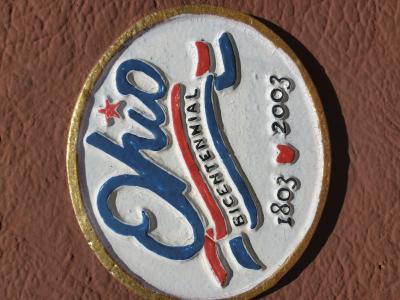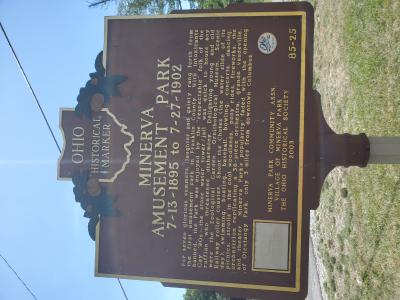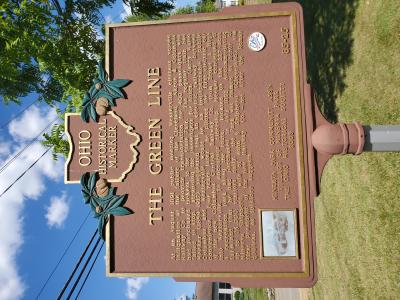
The proud heritage of Minerva Park is immortalized with a historical marker located at the northeast corner of the South Lake. Our appreciation for making this marker a reality goes to Barbara Donley for the initial concept and extensive research; to Bob Stuart, Minerva Park's de facto historian; and to Sharon Bierman, for the final text & design and for completing the process with the Ohio Historical Society and marker fabricator.

7-13-1895 to 7-27-1902
For seven glorious summers, laughter and gaiety rang forth from the first amusement park in Franklin County. With intoxicants banned, the Park was enjoyed by the “respectable” folk of the Gay ’90s—the stone water tower/jail was quick to house any ruffian who threatened disharmony. Delighting young and old were the Zoological Garden, Ornithological Museum, the Scenic Railway roller coaster, Shoot the Chutes (the water slide of its day), swimming, boating, baseball, bowling, concerts, dancing, picnics, strolls in the cool woodlands, pony rides, fireworks, the orchestrion replicating a 36-piece orchestra, grande vaudeville, and theater. Minerva Park’s popularity faded with the opening of Olentangy Park, only 3 miles from downtown Columbus.
Regarding the photo on the sign:
The original dance pavilion burned in September 1896. It was thought by some to be the result of an incendiary, but the manager attributed the fire to a cigar stump being thrown in the rubbish under the pavilion. This new “Casino” was constructed in only 37 days, just in time for the opening of the third season on June 27, 1897. It measured 242’ by 116’, with encircling verandas of 16’ and 25’. With “all games of chance or gambling of any kind prohibited,” the Casino was not a gambling house. Offering a 3,500-seat theatre, orchestra circle, restaurants, and gallery, it showcased the finest vaudeville acts of the time. The season ran from May to September.

At an August 1891 public meeting, Westerville citizens voiced indignation at the failure of the Cleveland, Akron & Columbus Railway Co. to provide transportation for 400 passengers who had purchased tickets to the State Fair. The regular train had failed to stop, stranding the passengers for hours. Garry Waldo Meeker (1859–1917) suggested that an electric railway between Columbus and Westerville would be an indispensable public convenience. Four years later, he piloted the first electric car of the new Columbus Central Railway Co. from Broad & High into Westerville. To encourage ridership, Meeker conceived of a recreation park along the route, located on the 227-acre farmland that he had purchased in July 1892. Accommodating up to 25,000 visitors daily, the Park was named in honor of Minerva Shipherd, wife of John S. Shipherd (Cleveland), the first president of the new Railway Co. – not after the Roman goddess, as folklore suggests.
Regarding the photo on the sign:
Departing from Town & High, the green cars reached Minerva Park in 54 minutes, traveling at an exhilarating speed of 12 mph. The 5¢ round-trip fare included admission to the Park and all activities. Passengers appreciated the 3,000-gallon sprinkler street car that traversed the line twice daily, keeping the dust along the route to a minimum by wetting the streets nearly curb to curb. This sketch depicts a car leaving the Westerville barn.
